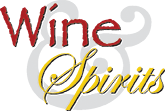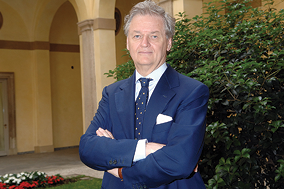- Home
- Media Kit
- Current Issue
- Past Issues
- Ad Specs-Submission
- Ad Print Settings
- Reprints (PDF)
- Photo Specifications (PDF)
- Contact Us

![]()
ONLINE


Giovanni Geddes da Filicaja
The Evolution of Ornellaia
Editors’ Note
Giovanni Geddes da Filicaja studied Economics at the University of Florence and entered the wine business in Italy in the early 1970s, eventually becoming CEO of Rémy Cointreau’s Italian company. After 12 years as CEO of Antinori, he took on the challenge of reorganizing the worldwide distribution for the Remy Cointreau Group. At the same time, he started consulting for Frescobaldi on their joint venture project called “Luce della Vite,” with the Robert Mondavi Corporation. In 1996, Giovanni became CEO of Frescobaldi and in 1999 became CEO of Tenuta dell’Ornellaia, which produces Ornellaia and Masseto.
Winery Brief
Ornellaia (ornellaia.com) is located in Bolgheri, a unique area in Italy where the classic Bordeaux varieties thrive. The Ornellaia estate is situated on the Via Bolgherese in the triangle between the sea, the medieval hamlet of Bolgheri, and the town of Castagneto Carducci. Ornellaia produces three highly acclaimed wines: Ornellaia, a blend of predominantly Cabernet Sauvignon, Merlot, and Cabernet Franc; Le Serre Nuove dell’Ornellaia, the ‘second vin’ of Ornellaia; and Le Volte dell’Ornellaia, a blend of Sangiovese, Merlot, and Cabernet Sauvignon. Eighty people work among the vines year round.
How has this brand evolved?
Ornellaia was founded in 1981. The region was known for Cabernet Sauvignon, Cabernet Franc, and Merlot, and the goal was to make the best possible international brand out of Bolgheri.
Marchese Lodovico Antinori developed Ornellaia. In 1997, he asked me to help him with handling the actual structure of the company because that was not his strength.
.png)
Casa Ornellaia in Bolgheri, Italy
Ornellaia was gaining popularity all over the world. He produced a very large crop in 1995, but to get a top quality wine, he knew he’d have to decrease production. That occurred in 1996 and 1997, and he decided to make the second wine.
By 1998, he became disenchanted with the business so he wanted to sell, but only to a foreign company. He sold a share to Mondavi with the option to buy the majority at the end of 1999. The Mondavis asked me to join as the CEO of Ornellaia in 1999.
Things evolved quite quickly. By the end of 2001, it was set up for Mondavi to take over fully. This was completed by the end of 2001 and we had a 50/50 joint venture between Mondavi and Frescobaldi.
I stayed on as CEO with a share of 5 percent, and Mondavi was sold in 2004 to Constellation. Since the beginning of 1997, I had been CEO of Frescobaldi and we had the option to buy it back from Constellation, so we bought back Luce and Ornellaia at the beginning of 2005.
We then moved our U.S. distribution to Folio Fine Wine Partners, which had been founded at the end of 2004 by Michael Mondavi.
What has been the secret to Ornellaia’s success?
The early days were very important with our focus on the quality of the wine. We wanted to make the best possible wine by far, not only in that region but in Italy and in the world.
We never took a shortcut on our investment in agronomy, or on our winemaking, and we cut down production, which we had to do. The Mondavis were pushing to have a very large extension of the winery but I wasn’t convinced that was the way to go.
When we went back, the market situation was a bit better. We started working on brand communications and on very high quality marketing. In 2005, we produced large formats, starting with magnums silk-screened with the 20th anniversary logo, which was a great success.
In 2006, we started what we called “Vendemmia d’Artista.” We looked for an artist to link to a particular wine. We invited renowned art critic and curator Bartolomeo Pietromarchi and art historian Maria Alicata to curate the project and artworks. We wanted to have an Italian artist who was really exuberant because that was our theme that year, and we found one of the most exuberant ones in Luigi Ontani.
In 2007, we did a theme with the United States, which was Harmony. The wine we used was very different, more elegant rather than strong. We came to the U.S. and found an Egyptian artist living in New York who produced a beautiful set of bottles.
Every year, we have a subject that represents the character of the vintage. We talk to the winemaker, hold brainstorming sessions, and decide on the character. Then we search for the artist who can best project that character. We prepare a presentation and bring the artists to our estate to get a feeling about them – then we choose one. The artist has to do one site-specific work of art, which stays at the estate – we now have seven. We then usually produce 111 large format bottles, 100 Double Magnums, 10 six-liter bottles, and only one nine-liter bottle.
We auction nine or 10 lots maximum with Sotheby’s and the money we raise we give to the museum where we have done the event.
We have given back 1.5 million Euro to charity, contemporary art, and music.

A bottle of 2011 Ornellaia
Where are the key markets today and where do you see opportunities for the future?
Our key markets are historical markets. Italy is number one. The U.S. is number two, immediately followed by Germany and Switzerland – both of which are over-performing. The U.K. is growing a lot, as is Canada. We have made quite a few efforts in Russia and it is growing enormously.
In Asia, we’re not very strong because Italy has around a 7 percent market share of imported wines there while France has about 47 or 48 percent. We’re growing there but very slowly, which hasn’t been a bad thing. Much of the demand for top bottle wines has gone to China and a lot of it hasn’t been drunk; it’s being stored somewhere. The supply didn’t go to the traditional markets so they’re losing market share in those markets in a big way. We have been very careful not to grow too much in any specific market.
We always want to create more demand than we can supply, so we look carefully at how the wine is being depleted and where.
We also separated the two top wines: Ornellaia and Masseto, which has much less production and is at a much higher price point. They were presented together at first, but the most expensive one becomes the wine in demand and more difficult to find, and the other becomes the second wine, so that was not good for Ornellaia. We kept distribution together only for Italy, the U.S., and Canada.
Today, Masseto is the most demanded wine in Bordeaux and the price on it has grown three times in a matter of six or seven years. The separation has also given far more light to Ornellaia.•